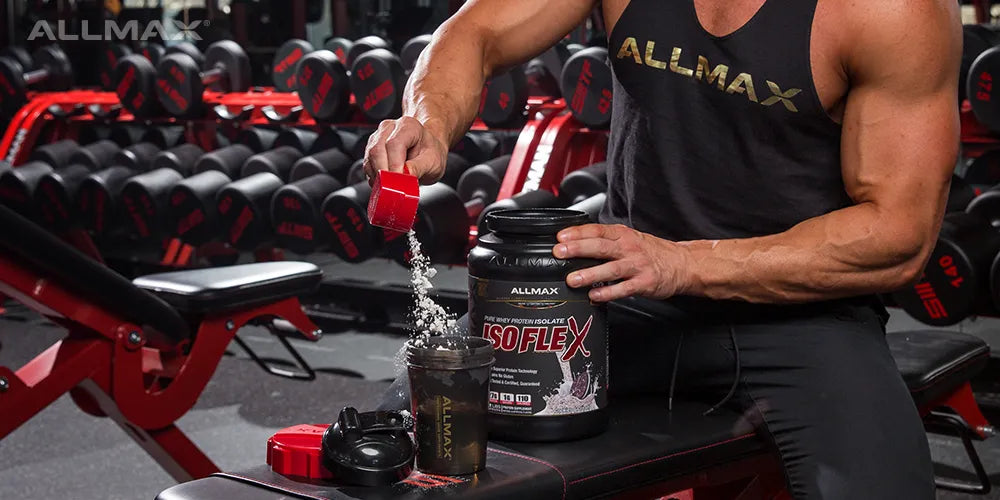When it comes to building serious muscle, the right supplements make all the difference. BCAA and creatine are two of the most powerful tools in your muscle-building arsenal; but which one truly delivers the results you want?
Whether you're grinding through intense workouts or pushing for that next personal best, understanding how these supplements work can help you fuel muscle recovery, increase muscle strength, and maximize gains. Let’s break it down and help you decide which one earns a place in your stack.
BCAAs or Creatine: Which One Is Better for Building Muscle?
Are you finding yourself plateauing in your workouts lately? Are you looking for a way to enhance your weight training, build lean muscle, and achieve a physique you’re proud of? If so, it’s time to look into adding supplements to your exercise routine. Two of the most popular supplements on the market today are BCAAs and creatine. Both promise to boost muscle gain as well as increase your energy and power during training. But which supplement is actually better for building muscle, BCAA or creatine? Let’s start by talking about what these supplements actually are, how they work in your body, and the benefits and drawbacks of each one.
BCAA: Branched-Chained Amino Acids
BCAA stands for branched-chain amino acids. They are a group of essential amino acids. That means that your body doesn’t produce them on its own, so you have to get them from outside sources like food or supplements. BCAAs include the amino acids valine, leucine, and isoleucine.
BCAAs for Muscle Growth and Recovery
BCAA supplements play a key role in supporting your muscle-building goals. Research shows they can help:
- Stimulate muscle growth. Leucine, one of the branched-chain amino acids, activates the mTOR pathway, which triggers muscle protein synthesis. A PubMed Central study found that participants who consumed 5.6 grams of BCAA after training increased muscle growth by 22% compared to those who took a placebo.
- Reduce muscle soreness. Intense workouts, especially new routines or heavy lifts, often cause delayed onset muscle soreness (DOMS). This can make simple activities like coughing or breathing uncomfortable, especially if your core muscles are sore. BCAA helps reduce muscle damage and protein breakdown during exercise, minimizing the intensity and duration of DOMS.
- Decrease muscle fatigue. By reducing tryptophan uptake in the brain during workouts, BCAA may help lower the perception of fatigue, helping you train harder for longer.
While BCAA supplements boost muscle protein synthesis, they work best alongside other essential amino acids found in complete protein sources like whey protein, eggs, turkey, fish, and some legumes. Without these, your body won’t reach its full muscle-building potential.
For optimal recovery, taking BCAA, especially before workouts, can help you bounce back faster and stay consistent in your training.
BCAA supplements don’t just help with muscle growth, they also play a key role in reducing exercise-induced fatigue. Here’s how it works:
- BCAA levels drop during workouts. As your muscles use up BCAA, their levels in the blood decrease.
- This triggers tryptophan uptake in the brain. Tryptophan is then converted into serotonin.
- Serotonin increases feelings of fatigue. While serotonin boosts your mood in daily life, during workouts it signals your brain that you’re getting tired.
By taking a BCAA supplement before your workout, you help maintain higher levels of these essential amino acids in your bloodstream. This can delay the rise in serotonin and help you train harder, for longer.
Key Benefits of BCAA for Athletes:
- Support lean muscle mass growth
- Reduce the severity and duration of muscle soreness
- Delay muscle fatigue during workouts
Remember: for the best results, combine BCAA supplements with complete protein sources like whey, eggs, poultry, fish, or legumes. This ensures your body gets all the essential amino acids it needs for full recovery and growth.
Creatine
Creatine, also known as creatine monohydrate, is also comprised of three amino acids, arginine, methionine, and glycine. Unlike BCAA, your body produces creatine naturally. It is also found in foods like lean meats and fish.
Creatine is primarily synthesized in your kidneys and then completed in your liver. The three amino acids are converted into creatine phosphate and phosphocreatine. These chemicals are stored in your skeletal muscles and converted to ATP for rapid energy use and muscle contraction.
When it hit the market in 1993, creatine quickly became one of the most popular workout supplements. Because it’s been around for almost 30 years, it has been studied extensively to determine its benefits and effectiveness.
Creatine for Athletic Performance and Recovery
Creatine is one of the most well-researched supplements for muscle gain, both in the short and long term. Its main benefit? Creatine supplementation increases the total work (or training volume) you can perform in a single session, which is a key driver of muscle growth.
In a 14-week study, adults who supplemented with creatine during weight training saw significant increases in leg strength and muscle mass. Another 12-week study on weightlifters found that creatine boosted muscle growth 2 to 3 times more compared to training alone. Plus, the athletes improved their one-rep max bench press faster than those taking a placebo.
Creatine doesn’t just help with muscle size. It also improves:
- Strength and power during high-intensity training
- Muscle repair and growth through enhanced cell signaling
- Recovery, by reducing muscle breakdown and lowering levels of myostatin, a protein that slows muscle growth
If your goal is lean muscle and lower body fat, combining creatine with weightlifting and cardio is a proven strategy to build the physique you want.
Creatine monohydrate is backed by strong clinical evidence showing real results in workout performance and muscle gain. But like any supplement, it’s not without a few potential downsides. Knowing how to manage them is key to getting the most from your training.
Side Effects of Creatine Monohydrate
Creatine monohydrate is generally safe, but some people may experience some side effects, especially when taking high doses.
Possible side effects of creatine monohydrate include:
- Bloating – may occur, especially during the loading phase.
- Stomach aches – digestive discomfort can happen with high doses.
- Muscle cramping – sometimes linked to dehydration or improper usage.
- Increased creatinine levels – a natural byproduct of creatine metabolism, though generally harmless in healthy individuals.
Many creatine supplements recommend a high-dose loading phase for the first 5–7 days of use. After that, the dose is reduced to a single serving, typically taken right after training. The loading phase can help you bulk up quickly, but it’s not essential.
As Dr. Chris Mohr, co-owner of Mohr Results, explains:
“While the loading phase is not dangerous or unhealthy, research suggests after 30 days, results from using creatine end up the same for strength gains. That said if someone needed faster results, for example, five days versus 30 days, then the loading phase could be considered.”
Whether you choose to load or not, staying hydrated is critical when supplementing with creatine. Drinking plenty of water helps minimize side effects and supports your body’s ability to convert creatine into ADP efficiently.
Differences Between BCAA and Creatine
Both BCAA and creatine can help build muscle, but they work in different ways. Your choice should depend on your body’s response and your training goals. While BCAAs support protein synthesis and recovery, creatine fuels your muscles with energy for heavier, high-intensity workouts. The only way to truly know which works best for you is through personal experience.
Feature |
BCAA |
Creatine |
Main Function |
Increases muscle protein synthesis and reduces breakdown, even without exercise |
Boosts ATP production for more strength and workout volume |
Muscle Growth |
Supports lean muscle gain, especially when combined with a complete protein source |
Strongly increases muscle mass and strength over time |
Workout Support |
Reduces muscle soreness and fatigue |
Increases strength, power, and workout capacity |
Effectiveness Backed by Research |
Mixed clinical results; less thoroughly studied |
Extensively studied with strong clinical evidence |
Fatigue & Recovery |
Helps reduce DOMS and muscle breakdown during exercise |
Speeds up muscle repair and reduces muscle breakdown |
Side Effects |
Generally minimal when used properly |
May cause bloating, stomach discomfort, or cramping (especially during the loading phase) |
Best For |
Supporting recovery and reducing soreness, especially for endurance or lighter training |
Increasing strength and muscle size, supporting high-intensity workouts |
Personalization |
Effects vary by person |
Effects vary by person |
When to Take BCAAs and Creatine
Choosing between BCAA and creatine depends on your goals and how your body responds. Both supplements support muscle growth but in very different ways—and timing can make all the difference. Here’s a clear breakdown to help you decide when and why to take each:
BCAA
- When to take: Before or during your workout
- Why: BCAAs provide your muscles with essential amino acids that reduce muscle breakdown and fight fatigue. They’re perfect for speeding up recovery and decreasing soreness, especially if you’re training hard, cutting calories, or doing endurance work.
- Goal: Maximize muscle recovery, reduce soreness, and sustain energy during long or intense sessions
Creatine
- When to take: Daily, ideally post-workout but timing isn’t critical as long as you’re consistent
- Why: Creatine fuels your muscles with extra ATP, the energy currency your body needs to push through heavy lifts and high-intensity workouts. This boost helps increase strength, power, and muscle size over time.
- Goal: Build strength, increase power output, and support muscle growth during intense training phases
In summary, use BCAAs to keep your muscles fresh and less sore during and right after your workouts, especially when you’re pushing endurance or recovering from calorie deficits. Choose creatine for consistent daily use to enhance strength, power, and overall muscle gains during heavy lifting cycles.
Both supplements have their place. understand your needs and time your intake accordingly to get the most from your training.
BCAA vs Creatine: The Choice is up to You
At the end of the day, you’re the one who has to decide whether BCAA vs creatine is more effective for building muscle. The answer may be different for you than it is for someone else. It all depends on how your body reacts to the supplements. So what’s the best way to figure out which supplement is right for you? Try them both. Cycle through one supplement and then the other and monitor your results. Both supplements have been proven to build muscle, it’s just a question of which one your body takes to more. If you’re ready to reach the next level of fitness, pick a supplement and try it out today. Whether you chose to start with BCAA or creatine, you’re guaranteed to see results. Conduct your own experiment using your body and figure out which one is right for you.



